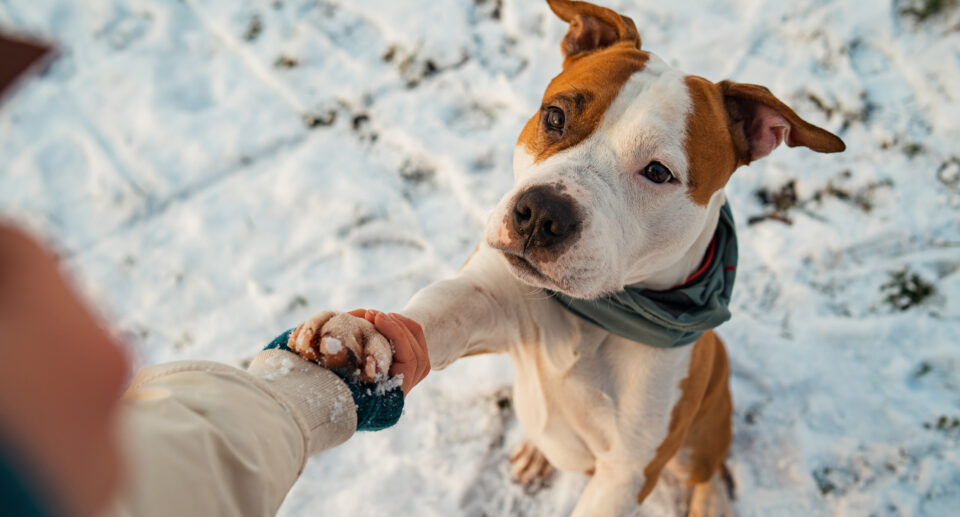
Winter can be tough on your dog’s paws. From walking on hard, frozen ground to harsh road salt, it’s no wonder so many dogs suffer from cracked, dry paw pads in cold weather. Use these tips to protect your dog’s paws this winter.
Should My Dog’s Paws Be Soft or Rough?
It’s normal for your dog’s paw pads to feel rough, even scratchy to the touch.
The thick, textured skin on the bottom of your dog’s paw pads function similarly to the soles of a good pair of boots. Rough paw pads provide traction, and so long as they’re not cracked or painful, they should stand up fairly well to most outdoor surfaces.
Healthy paw pads may feel somewhat dry, but not cracked or brittle. Your dog’s paw pads have a moisture barrier made up of lipids, proteins, and dead skin cells. This barrier helps retain the skin’s flexibility and moisture and provides resistance against cracking, flaking, and peeling. By regularly walking your dog year-round on various terrains like sidewalks, roads, hiking trails, and city streets, their paw pads will become tougher against the elements. That said, even the toughest paw pads occasionally need care and extra protection to stay strong and healthy.
Protecting Your Dog’s Paw Pads
The key to protecting your dog’s paw pads in the winter is to keep the paw pad skin moisture barrier intact.
Nutrition is essential for strong, healthy paw pads. Omega-3 fatty acids help nourish the skin’s moisture barrier, while vitamins A, C, D, and E are important for skin healing. Your dog’s food should already be complete and balanced, but you may want to try a speciality skin and coat dog food or a skin and coat supplement if their skin health needs a boost.
Even with skin and coat nutritional support, low humidity and cold temperatures in the winter can absorb moisture from the skin, leaving your dog’s paws more vulnerable to dryness and cracking.
Salt-based ice melting products can also draw moisture from the skin’s barrier, leaving your dog’s paws irritated with prolonged or repeated exposure. Once the paw pads are already cracked or irritated, your dog can become more susceptible to painful chemical burns.
By limiting your dog’s exposure to cold weather, icy surfaces, and ice melt, you can help keep their paw pads healthy. For short winter walks limited to about 20 minutes, it may be enough to simply wipe your dog’s paws with paw wipes when they come inside.
But that doesn’t mean you can’t go for longer walks and even hikes in the winter. Rougher terrain and extended exposure may require more paw protection.
Does My Dog Need Booties?
Footwear can be a great way to protect your dog’s paws during outdoor adventures, especially if you expect to encounter hard, cold surfaces, ice, and ice melt for extended periods of time.
After all, even sled dogs sometimes wear booties. For short runs and mild conditions, it’s common for them to go without. But for longer adventures when they take fewer breaks, or are more likely to run across rough terrain, many sled dog teams wear boots.
When To Use Paw Balm
A paw balm like Paw Rescue is applied directly to your dog’s paw pads before going for a walk. It’s made up of nourishing oils that help replenish the skin’s moisture barrier, plus wax to help it form a protective layer on the skin.
While it’s safe to ingest if licked, paw balm is best used before walks. You can also use it after wiping your dog’s paws clean when they come back inside.
Cleaning Your Dog’s Paws After Walks
You can wipe your dog’s paws clean after a walk to remove highly toxic substances like antifreeze, melting salts, and chemical ice melts. These substances are poisonous if licked, and can cause skin irritation with prolonged contact.
To clean your dog’s paws, use a paper towel or rag, either dry or moistened with warm water. Add a dab of dog shampoo for exceptionally dirty paws. You can also use PawZ paw wipes or Earthbath Grooming Wipes.
Avoid using made-for-humans soaps, lotions, or detergents on your dog’s paws. Harsh cleansers can dry out their skin, making them more susceptible to cracking.
After cleaning your dog’s paws, you can moisturize with Paw Rescue. Home remedies like coconut oil can work in a pinch, but your dog is more likely to lick it off, and won’t provide long-lasting protection of a paw balm.
Caring for Dry, Cracked Paws
Keeping your dog’s paws clean and moisturized can help prevent dryness, irritation, and cracking. But what if their paws are already chapped?
Cracked paw pads may be sore to walk on and can become infected. Use a wound care ointment like Derma-Clens cream to protect against infection and speed up healing. Open wounds should be kept covered, especially when your dog is outside.
Liquid bandage spray creates a waterproof seal that protects wounds, and it has a bitter taste that discourages your dog from licking or biting their paw.
If your dog’s paws are bleeding or painful, see a veterinarian as soon as possible or make a same-day televet appointment with VetLive.





